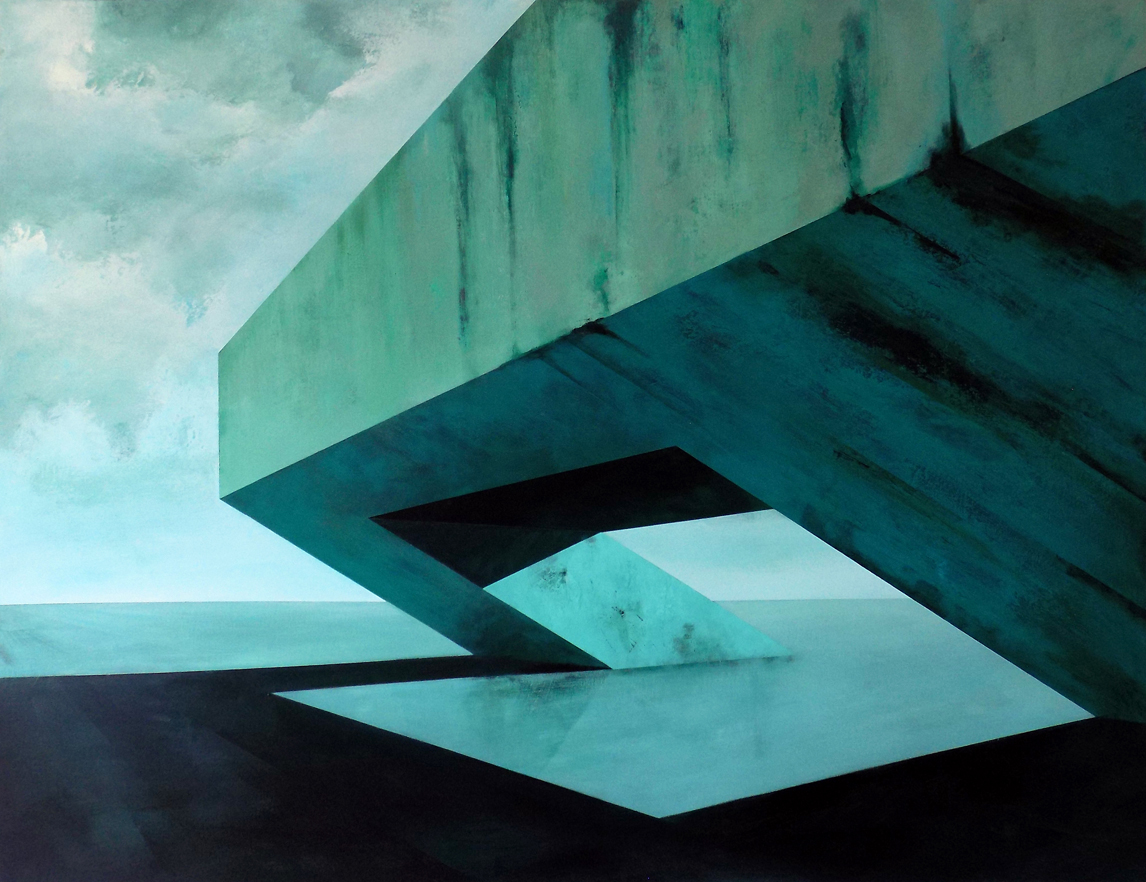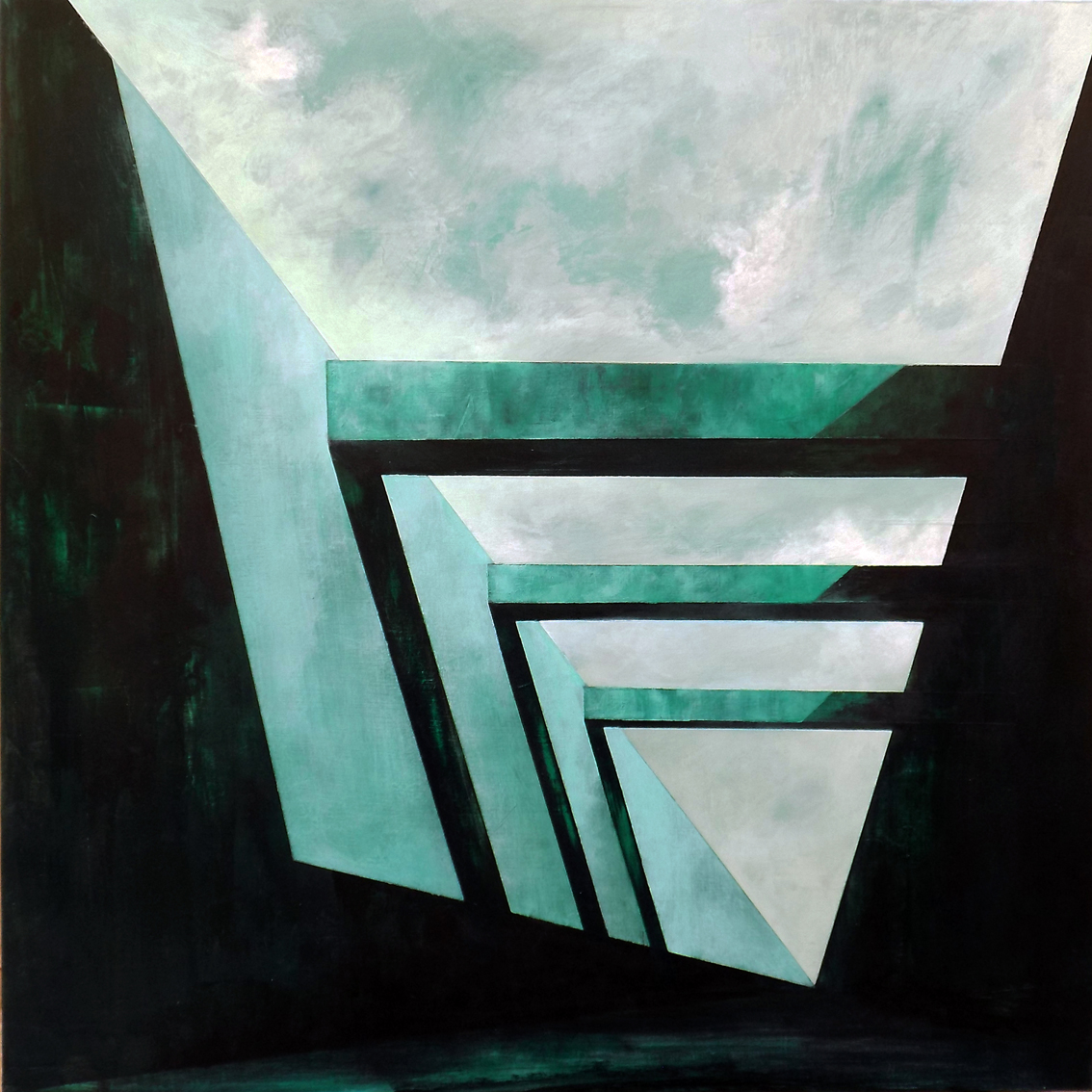When the shadow falls, we all become part of the spectrum: visiting the metaphysical spaces of Rafa de Corral
Viewed from a certain perspective, it's possible that the lucid impression – intimate and visible – of the transparency of the ephemeral over the opacity of the eternal constitutes the unyielding motif of the artist Rafa de Corral's work. It's about – if we translate it into the metaphysical realm – the imprint of time on existence, the furrow of the sensible in the volumes of dreams, or, in other words, a certain effect of the ephemeral on the will (on illusion) of permanence. The constant themes of the artist from Bilbao – uninhabited spaces illuminated under perspectives both plausible and illogical, unsettling urban topographies of phthalocyanine green and postmodern signage under certain aspects of a hyperrealist poetics, perspectives of the architecture of the world from a physical and metaphorical rooftop, metonymies of finitude and emptiness – are thus renewed throughout a very coherent trajectory from a duality (here a trinity: "Umbra, penumbra, and antumbra") explicit in the label of his works.

They are observed on an edge of space-time, in a landscape that outlives us where, if the viewer sharpens their sight well, it's possible to distinguish alongside the traces of days in matter (a slight chipping, the impression of a puddle, a vestige of rain), in spaces of shadows and vital penumbra, the trail and erosion of life's own consciousness.
There's a craft that disrupts the dictate of time, a skill that resolves – in guessed sketches and previous studies of a meticulous artist – the architectural and vital tension laden with counterweights and enigmas. And that prophesied ghostly quality in horizons (as end or as goals: telos the Greeks said) mysterious, at the bottom of spaces outside history under skies in processes of change allows one to read Rafa de Corral's work as "hauntology" in the terms Mark Fisher took from Jacques Derrida. Because to be visited by ghosts (the viewer-specters who attend here and now to his work) is not only to have memory of what was not experienced in the present (that which never took the form of presence) but to subject the trace of dreams to a perspective that unites image, politics, and psychoanalysis with the science of the ghostly. And, don't we suddenly think of ourselves as finite, eccentric, and non-fundamental in this orography of the perpetual? Doesn't art, and not only cinema, radiate a light where the shadow falls upon us? Thus, the artist's preference for twilight, cut clouds, announced darkness, the disappearance of the human in the desert of time, the elevation of forms in silence is deciphered.
Y allí donde los puntos de luz unidireccional, los nuevos puntos cardinales, el bloque metafísico y otras constantes formales remiten la pintura de Chirico, allá donde en un plano anímico, la soledad de los espacios esquinados cursa correspondencia con las almas solitarias de Hooper (la incomunicación y el vacío), allá donde Tanizaki tematizó en su elogio de las sombras todo lo que confiere a los intersticios y al mundo umbrío un aire de hondo misterio, encontramos la original personalidad de la obra de Rafa de Corral, a la vez melancólica y arrolladora. Si para Jung, la sombra es un arquetipo del inconsciente colectivo y un aspecto oculto e inconsciente de la personalidad, para de Corral la sombra comunica –por buscar una aliteración cercana al título de esta exposición– el poético efecto de lo ligero en la reciedumbre del durar.
Las sombras se nos antojan así las hijas de aquella permanente embestida de lo tenue con las que comenzábamos a hablar y a caminar timbrando nuestra propio reflejo en los muros de la exposición que nos trae aquí. ¿No acompañaba también la sombra que Platón asoció a la ilusa percepción de lo real y que Jung ligó el lado oscuro, a la voluntad de poder del caminante de Nietzsche?

We gaze at structures upon which seems to have congealed a millennial air and which enclose in the deepest the brightness of a stagnant utopianism. The naked landscapes have survived humanity or perhaps it inhabits under unsettling lights under the shelter of the singular architecture of our artist in ghostly corners of his very personal metaphysics of the urban. There are elements – the folded concrete pieces – that seem attracted by the gravity of a greater light star. It's also not unlikely that they have abandoned us as they seem to want to desert from the support as the pieces that rise in the installation to the wall that surrounds us. Let us observe, then, the play of lights, their impact on volumes, the collimated beam proper of a disappeared star, its ethereal shadows and its subtle darknesses. Let us blink incredulously in the dreamy penumbra where the pieces float with the sensation that a foggy future will one day eclipse the light of our sight without erasing the slight trace of our existence, of our very light presence, in the sensitive orb of that celestial body that is Earth. Meanwhile, de Corral will continue to examine the articulation between the visible and the invisible, the dreamlike improbability of threedimensionality – umbra, penumbra, and antumbra – the liberation of the pieces parallel to an aesthetic resolution: the slow, unstoppable, aerial displacement towards abstraction from the figurative.
Jesus García Cívico (cultural critic)